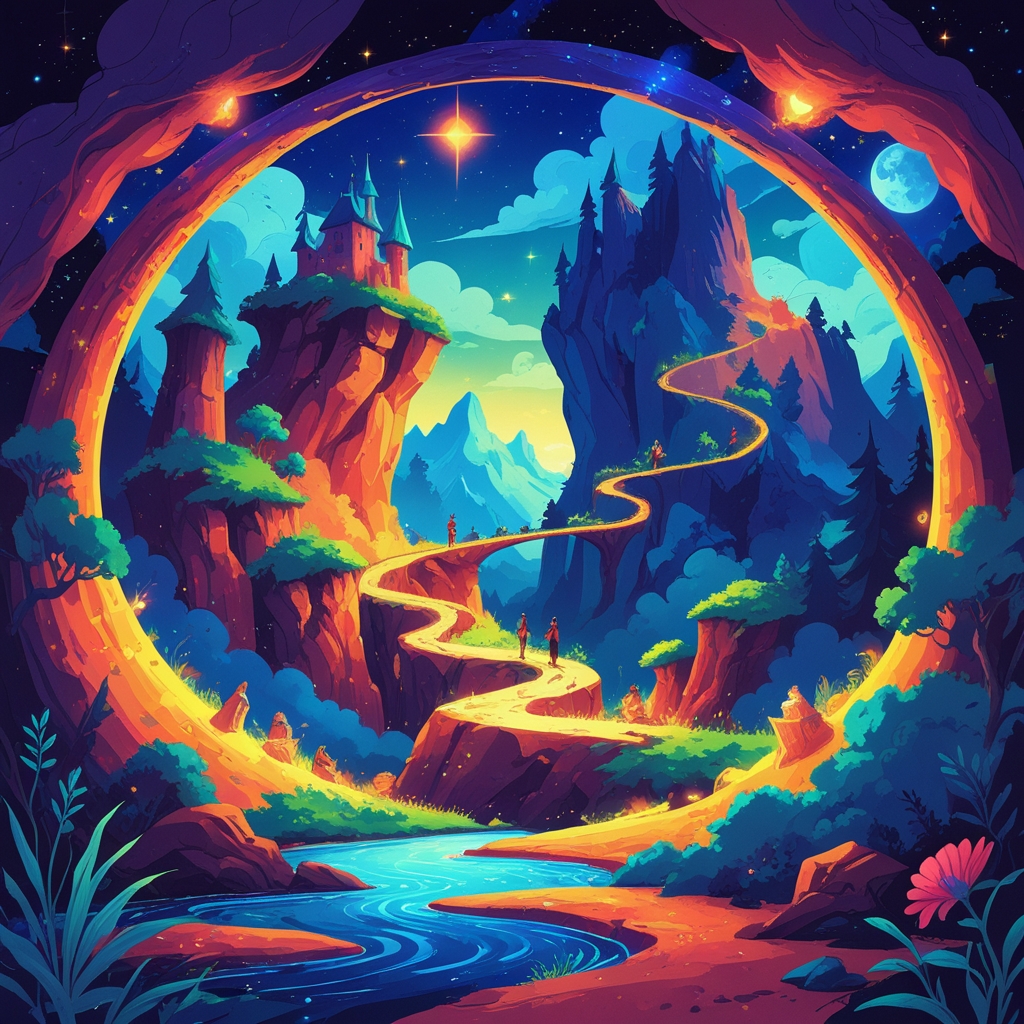
From Frogs to Dragons: How the Hero’s Journey Shapes Our Favorite Fairytales
Ever notice how so many fairytales seem to follow a similar pattern? A humble protagonist, a call to adventure, a series of trials, and a triumphant return? That, my friends, is the power of the Hero’s Journey, also known as the Monomyth – a narrative structure so fundamental to storytelling that it shows up again and again, across cultures and centuries.

And let’s be real, if it wasn’t so effective, would we still be telling these stories? We at Fairytales: ReImagined think not.
This isn’t just some dusty academic theory, though. It’s a blueprint for creating compelling and resonant narratives. And when it comes to fairytales, the Hero’s Journey is practically a built-in feature. It’s in the water, in the magic beans, and definitely in the poisoned apples.
What is the Hero’s Journey, Anyway?
For those unfamiliar, the Hero’s Journey, popularized by mythologist Joseph Campbell, is a narrative template that describes the common stages of a hero’s adventure. It’s a cyclical pattern that can be found in myths, legends, and stories from around the world.
In simple terms, it goes something like this:
- The Ordinary World: The hero lives a mundane life, unaware of their potential.
- The Call to Adventure: Something disrupts the hero’s ordinary world and presents them with a challenge or quest.
- Refusal of the Call: The hero hesitates or refuses to accept the call, often due to fear or doubt.
- Meeting the Mentor: The hero encounters a wise figure who provides guidance and support.
- Crossing the Threshold: The hero commits to the adventure and enters a new and unfamiliar world.
- Tests, Allies, and Enemies: The hero faces challenges, forms alliances, and encounters enemies along the way.
- Approach to the Inmost Cave: The hero prepares for the ultimate challenge or confrontation.
- The Ordeal: The hero faces their greatest fear or challenge and experiences a major crisis.
- Reward (Seizing the Sword): The hero overcomes the ordeal and gains a valuable reward or insight.
- The Road Back: The hero begins the journey back to the ordinary world.
- The Resurrection: The hero faces a final test that demonstrates their transformation.
- Return with the Elixir: The hero returns to the ordinary world with newfound wisdom, power, or knowledge that benefits others.
How the Hero’s Journey Plays Out in Fairytales
Now, let’s see how these stages manifest in some classic fairytales:
- Cinderella: Cinderella’s ordinary world is her life as a servant. The call to adventure is the invitation to the ball. The mentor is her fairy godmother. The ordeal is facing her stepmother and stepsisters after the ball. The reward is marrying the prince and escaping her oppressive life. (Link to Disney’s Cinderella page)
- Little Red Riding Hood: Little Red Riding Hood’s ordinary world is her journey to grandma’s house. The call to adventure is her mother asking her to deliver goods. The ordeal is facing the wolf in grandma’s bed. The reward (often overlooked) is her rescue and the lesson she learns about stranger danger. (External link to a site detailing the different versions of Little Red Riding Hood)
- Jack and the Beanstalk: Jack’s ordinary world is his impoverished life with his mother. The call to adventure is his decision to sell the cow for magic beans. The mentor is the mysterious old man who gives him the beans. The ordeal is climbing the beanstalk and facing the giant. The reward is the giant’s treasure, which helps Jack and his mother escape poverty.
- Snow White: Snow White’s ordinary world is her life as a princess. The call to adventure is the evil queen’s attempt on her life. The mentor is the seven dwarfs. The ordeal is eating the poisoned apple. The reward is being awakened by the prince and reclaiming her rightful place as queen.

Why the Hero’s Journey Resonates with Us
The Hero’s Journey isn’t just a convenient storytelling device. It taps into something deeper within us. It reflects our own journeys of self-discovery, our struggles to overcome challenges, and our innate desire for transformation.
We see ourselves in these heroes, even if they’re talking frogs or enchanted princesses. Their struggles mirror our own, and their triumphs inspire us to believe in our own potential. Because let’s face it, who hasn’t felt like they’re living in a terrible situation or are in danger of being taken advantage of? (This is just my own feelings.)
It’s a reminder that even in the darkest of times, there’s always hope for a brighter future. And that, my friends, is a message that never gets old.
Subverting the Journey: Modern Twists on a Classic Structure
While the Hero’s Journey provides a solid framework, modern storytellers are increasingly subverting and reimagining this pattern. They’re creating flawed heroes, questioning traditional power structures, and exploring alternative narratives that challenge the very notion of a “happily ever after.” (Internal link to a blog post about subversive fairytales)
This subversion doesn’t diminish the power of the Hero’s Journey. Instead, it expands its possibilities, allowing us to explore new themes and perspectives while still tapping into the fundamental elements that make these stories so compelling.
(image suggestion 4): A digital illustration of a “broken” or deconstructed Hero’s Journey diagram, with elements jumbled, altered, or reimagined.
(AI Prompt for above:) Surreal digital art. Deconstructed Hero’s Journey diagram. Fractured elements. Remix of fairytale objects. Twisted symbols. Creative.
Your Thoughts?
Can you think of other fairytales that fit the Hero’s Journey pattern? Share your examples in the comments below! We’d love to hear your thoughts. And don’t forget to subscribe to our blog for more fairytale analysis, reimagined stories, and general storytelling shenanigans. (Link to Blog). Join our newsletter for weekly updates. (Link to Newsletter) Finally, take a listen to the Fairytales Re:Imagined podcast at (link to the podcast). The story of your life is just beginning!